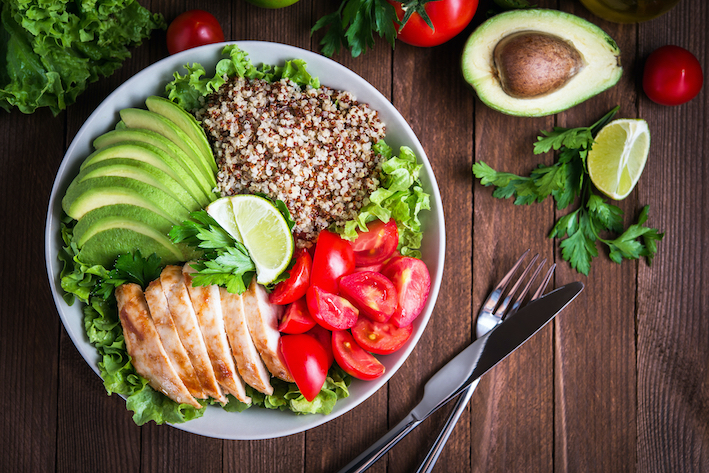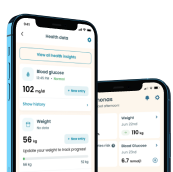The perfect food plate for people with diabetes

If you know somebody with diabetes, or are perhaps diabetic yourself, then you will know just how much food and its nutritional content can matter on a minute-by-minute basis during the day.
In this modern age of health consciousness, many people are much more mindful of healthy eating patterns and the calories and ingredients that they put into their bodies. When you have diabetes, however, this consciousness of healthy eating takes on a whole new significance.
Rather than thinking about small-scale issues like skin complexion or hitting a calorie target for the day, those who have diabetes have to pay much more serious attention to the foods that they consume. In very serious and sensitive cases, making sure that you as a diabetic have the perfect plate of balanced food following United States government guidelines could be the difference between maintaining good health and becoming ill.
What Is Diabetes?
In simple terms, diabetes is a chronic (long-lasting) condition that negatively affects the way that your body is able to turn food into energy.
Most of the food that you eat every day gets broken down into glucose, which is essentially sugar and is then released into your bloodstream.
When this release happens and your blood sugar rises, what should normally happen is your body sends a signal to your pancreas to release the insulin hormone. Insulin acts like a gatekeeper, unlocking the door of your body for blood sugar to be used as energy.
If you have diabetes, your body is not able to make enough insulin to successfully complete this task, or it is unable to make the best use of the insulin that it does create. When there is insufficient insulin and it can’t perform its function efficiently, too much sugar stays in the bloodstream, which can lead to problems ranging from vision loss to kidney disease to heart disease and more.
There are two main types of diabetes – type I and type II. Type I is usually congenital while type II is acquired. Diabetes cannot be self-diagnosed and must be confirmed by a medical professional.
Type II diabetics can manage their condition through lifestyle changes such as losing weight, eating healthy food, and being active.
Type I diabetics have to maintain insulin levels by introducing it directly into their bodies and also follow healthy eating patterns in order to manage their condition.
How Does Diabetes Affect The Body?
Before a diagnosis, diabetics usually experience symptoms such as
- An increased thirst that can’t seem to be satisfied.
- A much more frequent feeling and need to urinate.
- A higher level of fatigue than your daily exertions should warrant.
- Moments and periods of blurred vision.
- A sensation of tingling or slight pain in all or some of the hands, feet or legs.
When not properly medicated and controlled by lifestyle changes, diabetes can have a massively negative impact on the body. Due to the fact that it contributes to high blood pressure, diabetes massively raises the risk of heart-related problems and strokes.
People who do not make serious changes to their lives are also very likely to lose much, if not all, of their vision over time. This is due to the damage caused to blood vessels by high sugar levels.
Another area of concern is the kidneys. Function deteriorates over time, particularly if issues such as high blood pressure and high cholesterol are not addressed.
The Relationship Between Diabetes And Food
The relationship is complicated because it is multifaceted.
Diabetes affects how the body processes fat, protein and carbohydrates and its ability to turn them into energy (sugar). All these nutrients require insulin but, carbohydrates, for example, needs insulin immediately after it is ingested.
If your body is unable to sufficiently cope with even average amounts of sugar, then it makes perfect sense that you need to start cutting out as much sugar from your diet as you possibly can.
Diabetics also need to be conscious of eating healthy to avoid weight gain. Excess weight can exacerbate any problems diabetes can cause.
Somebody who has diabetes should maintain a healthy diet that includes all of the nutrients and ingredients that are needed in order to give the body the energy that it needs. This isn’t the kind of eating that involves fasting and crash dieting to lose weight. Rather, this is a complete lifestyle that will help you to keep your diabetic symptoms under control.
Alongside insulin and any prescribed medications, eating right is the best thing you can do to control your diabetes. Experts have devised some guidelines to help called the Diabetes Plate Method.
What Is The Diabetes Plate Method?
The Diabetes Plate Method is also known as MyPlate. MyPlate is used in nutrition counseling for both diabetes and general healthy eating.
Developed and approved by award-winning, groundbreaking experts in the fields of diabetes and nutrition, the official website of MyPlate is maintained by the United States Government Department of Agriculture.
This federal-backed nutrition policy encourages healthy eating for all Americans not only with what foods to eat but also has beneficial educational purposes that help us understand more about the food we eat. By having a greater understanding of the healthy eating pyramid and food groups, everyone can produce balanced meals.



Using this method, you follow the dietary guidelines to create meals that are not only perfectly portioned in terms of calories, but also optimally balance important and essential nutrients from all food groups.
Here is an easy-to-understand and easy-to-follow guide to using the Diabetes Plate Method.
Choose a dinner plate in your kitchen that is not too big and not too small. Ideally, this should be about 9 inches in diameter. Don’t choose an overly large plate – you need the visual aspect of food filling the plate to aid the mental processes of hunger.
- First, visualize the plate in four quarters. This food plate chart is an essential of the MyPlate guidelines and it will make it easier to build the ideal meal with different foods.
- Now fill half of the plate with non-starchy vegetables. Non-starchy vegetables are low in carbohydrates, which means that they do not significantly raise your blood sugar levels. They are also very high in minerals, vitamins and fiber, and should make up at least half of your meal. Examples of non-starchy vegetables
- Broccoli
- Cauliflower
- Asparagus
- Carrots
- Cucumber
- Okra
- Eggplant
- Green beans
- Tomatoes
- Peppers
- Salad greens
- celery
- Cabbage
3. In one quarter of the plate, add your protein. It should be high in protein but low fat. Protein, especially from animal sources, can contain too much saturated fat, and this increases the risk of heart disease. Red meat, for example, is best avoided as a prime nutrition source. Some of the good sources of lean proteins are
- Eggs
- Poultry (chicken and turkey)
- Oily fish like salmon, trout, tuna
- Lean pork
- Shellfish
Some of the best plant-based sources of protein are
- Edamame
- Tofu
- Tempeh
- Beans
- Lentils
- chickpeas
- Nuts
4. The final quarter of your plate is for carbohydrates. Some carbohydrates are essential for maintaining a healthy and balanced diet, but too many carbs can raise blood sugar immediately after consumption.
Examples of healthy carbohydrates
- Whole grains like bulgur wheat, brown rice and quinoa.
- Whole grain products like pasta and bread.
- Starchy veggies like butternut squash, green peas, pumpkin, sweet potato and plantain.
- Legumes and beans like garbanzo, kidney, black and pinto.
- Portions of fresh and dried fruit.
- Dairy products like yogurt and milk, as well as milk substitutes such as soy.
5. Although not included on the food plate chart, the final step is to choose the beverage that accompanies the meal. A glass of water is the very best option. It contains zero calories, zero carbohydrates and has zero effect on blood sugar.
Other options include
- Unsweetened tea (both hot and cold)
- Sparkling water/club soda
- Diet sodas with zero calories.
- Unsweetened coffee (both hot and cold)
- Flavored waters that don’t contain any calories.
So to recap, the ideal diabetic plate is one quarter lean protein, one quarter unrefined carbs and two quarters vegetables. It’s about learning what you can and can’t eat and in time, practice and knowing how to plate food will result in healthy eating habits without needing the visual clue of the food plate chart. Using a diabetes management app will also aid the process.
What foods should a diabetic person avoid?
The cruel part of being diabetic is the list of foods that are ‘off limits’ are generally delicious, guilty pleasure foods that would normally be the first thing you would order off a menu.
They range across all five food groups but no whole group is ruled out. They are not prohibited as such, but to manage diabetes and for general healthy eating, they should be limited but best avoided.
Sugary Drinks
You would be amazed by the amount of sugar in a can of soda. In addition to the glucose, most sugary sodas also contain fructose, another type of sugar that has been linked to insulin resistance. For obvious reasons, it is advisable to stick to the zero-calorie diet versions of fizzy and other soft drinks such as heavy fruit-based drinks.
Trans Fatty Acids
Also known as trans fat, this is a type of saturated fat that is artificially made to be stable and have a longer shelf life. You will find trans fats in most cheap processed snacks and foods, and they have been identified as contributing to insulin resistance. Most dietary guidelines suggest avoiding foods containing trans fats if you follow healthy eating habits. Avoid margarine and butter substitutes (spreads) and choose olive oil over other types.
Refined Grains
Refined grains are processed grains. Unlike whole grains which have multiple health benefits, refined grains have been so processed that most of their nutritional goodness is lost. The downside of this is that foods made from refined grains are very high in carbohydrates. Sadly, refined grains also make up the bulk of the basic Western diet – white bread, white pasta and white rice.
It is much better to choose brown (whole grain) versions. There are plenty of different types of bread and lots of different shapes of whole wheat pasta.
Fruit Flavored Yogurts
You might think that, unless you are lactose intolerant, yogurt would be a good Myplate food. Dairy yogurt comes in low fat versions made from low fat milk, sits nicely in the protein group, has good nutritional value and is said to have numerous health benefits.
This is certainly applicable to plain yogurt but when you move into the realms of fruit and fancy yogurts, the sugar content should be a cause for concern for diabetics. Some fruits are very high in sugar. If you opt for a non-dairy option, the product is usually loaded up with stuff to make it taste like yogurt. Compare the calories of flavored and non-dairy yogurts against plain yogurt to see the difference immediately.
Sweetened Breakfast Cereals
This is important to know because so many cereal companies gear their advertising to kids, positioning their cereals as a sensible, healthy breakfast option. Despite the various health claims on the boxes of sweet-tasting cereals, they are incredibly processed, incredibly high in sugar, and incredibly high in carbohydrates … all things to avoid when you are diabetic and trying to stick to good foods on the healthy eating pyramid. MyPlate balanced meals include breakfast and there are many good choices of cereals based on whole grains.
Summary
It might seem that as a diabetic, you have to follow the same sort of restricted diet as someone trying to lose weight but if you are committed to keeping your blood sugar levels down, then you have to play by the rules of the science.
With the help of the Diabetes Plate Method and the knowledge of foods to avoid, you should be able to control your diabetes and enjoy a healthy, happy life.
Take a quiz and get your diabetes-management plan today!








